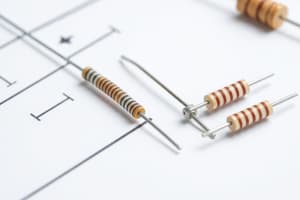Podcast
Questions and Answers
In a series circuit, how does the voltage compare across each resistor?
In a series circuit, how does the voltage compare across each resistor?
- The voltage varies depending on the resistor's position
- The voltage decreases across each resistor
- The voltage is the same across each resistor
- The voltage increases across each resistor (correct)
What happens to the current in a parallel circuit as resistor values increase?
What happens to the current in a parallel circuit as resistor values increase?
- The current through each resistor remains constant
- The current through each resistor increases
- The current varies unpredictably
- The current through each resistor decreases (correct)
What does the total resistance in a series circuit depend on?
What does the total resistance in a series circuit depend on?
- Individual resistance values of the resistors (correct)
- Voltage across each resistor
- Current flowing through each resistor
- Number of resistors connected in series
How are resistance values combined in a parallel circuit to calculate the equivalent resistance?
How are resistance values combined in a parallel circuit to calculate the equivalent resistance?
What is the formula to calculate the total resistance in a series circuit?
What is the formula to calculate the total resistance in a series circuit?
What does Ohm's Law state?
What does Ohm's Law state?
In a parallel circuit, how do you find the total resistance?
In a parallel circuit, how do you find the total resistance?
What feature is Bing Chat working on related to answering math and circuitry questions?
What feature is Bing Chat working on related to answering math and circuitry questions?
Flashcards are hidden until you start studying
Study Notes
Combining Resistors: A Circuit Adventure
Imagine you're crafting a path for electricity, and you've got resistors—little roadblocks that slow down the flow. Now, imagine combining those resistors into circuits to create new, intriguing routes. Let's explore the concepts of series and parallel circuits, resistance values, equivalent resistance, and how it all relates to Ohm's Law.
Series Circuits
In a series circuit, resistors are connected one after another like a single line of cars. The current flowing through these resistors is the same, but the voltage across each resistor adds up, resulting in a larger voltage across the entire circuit. Here, the total resistance is the sum of the individual resistances: (R_{total} = R_1 + R_2 + ... + R_n).
Parallel Circuits
In a parallel circuit, resistors are connected in a "T" or "Y" configuration, creating multiple paths for the same current to flow. The voltage across each resistor is the same, but the current through each resistor varies depending on that resistor's value. The reciprocal of the equivalent resistance in a parallel circuit is the sum of the reciprocals of the individual resistances: (\frac{1}{R_{total}} = \frac{1}{R_1} + \frac{1}{R_2} + ... + \frac{1}{R_n}).
Resistance Values Calculation
Resistors have their own inherent resistance value, measured in ohms ((\Omega)). These values can range from fractions of an ohm to millions of ohms, and resistors can be combined to create new resistances.
Equivalent Resistance
To find the equivalent resistance in a series or parallel circuit, use the formulas mentioned in the previous sections. For series circuits, add the individual resistances: (R_{total} = R_1 + R_2 + ... + R_n). For parallel circuits, use the reciprocal of the sum of reciprocals: (\frac{1}{R_{total}} = \frac{1}{R_1} + \frac{1}{R_2} + ... + \frac{1}{R_n}).
Ohm's Law
Ohm's Law—(V = I \times R)—describes the relationship between voltage, current, and resistance. In words, it tells us that the voltage across a resistor is equal to the current through the resistor multiplied by its resistance.
Why Bing Won't Search for Answers
When you ask Bing Chat questions about math and circuitry, you might want it to provide answers without searching the web. Bing Chat is working on a "No Search" feature, which allows users to opt-out of web searches to reduce noise and focus on direct answers.
Summary
Understanding how resistors behave in series and parallel circuits allows you to design and analyze electronic circuits. The equivalent resistance in these circuits follows a simple mathematical approach, and Ohm's Law provides a framework for understanding the relationships among voltage, current, and resistance. With the upcoming "No Search" feature, Bing Chat may provide more targeted, educational responses to questions in this area without the need for web searches.
Studying That Suits You
Use AI to generate personalized quizzes and flashcards to suit your learning preferences.




